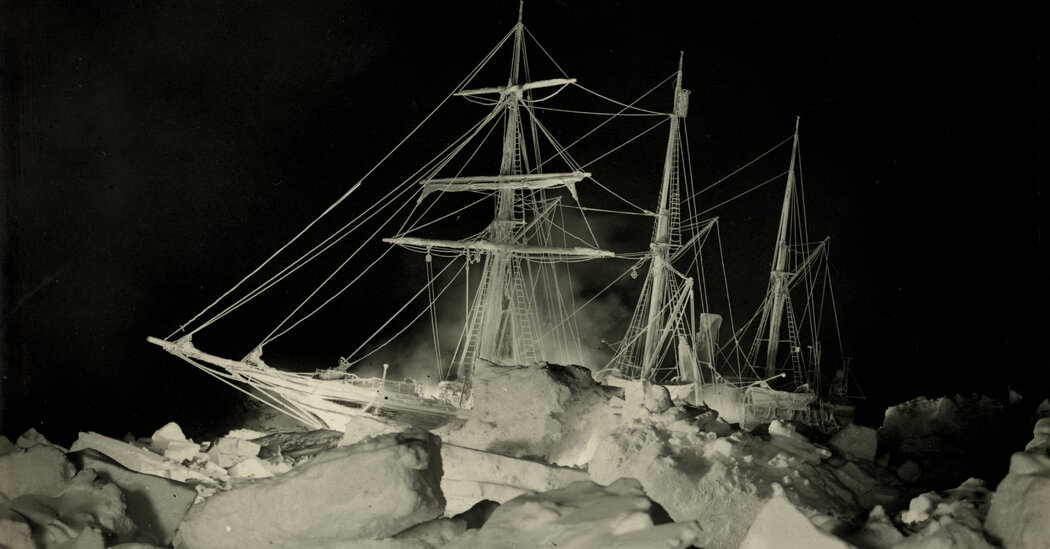Explorers and researchers, battling freezing temperatures, have located Endurance, Ernest Shackleton’s ship that sank in the Antarctic in 1915.
The wreck of Endurance has been found in the Antarctic, 106 years after the historic ship was crushed in pack ice and sank during an expedition by the explorer Ernest Shackleton.
A team of adventurers, marine archaeologists and technicians located the wreck at the bottom of the Weddell Sea, east of the Antarctic Peninsula, using undersea drones. Battling sea ice and freezing temperatures, the team had been searching for more than two weeks in a 150-square-mile area around where the ship went down in 1915.
Endurance, a 144-foot, three-masted wooden ship, holds a revered place in polar history because it spawned one of the greatest survival stories in the annals of exploration. Its location, 10,000 feet down in waters that are among the iciest on Earth, placed it among the most celebrated shipwrecks that had not been found.
The discovery of the wreck was announced Wednesday in a statement by the search expedition, Endurance22.
The first images of the ship since those taken by Shackleton’s photographer, Frank Hurley, revealed parts of the vessel in astonishing detail. An image of the stern showed the name ENDURANCE above a five-pointed star, a holdover from before Shackleton bought the ship, when it was named Polaris.
Another image, taken from above, shows the ship’s open rear deck and entrance to the main quarters. The pressure of the ice had heavily damaged Endurance before it sank, and in the image the forward part of the ship appears to be badly broken up.
The expedition’s exploration director, Mensun Bound, had said that with the cold water and lack of wood-eating marine organisms in the Weddell Sea he expected the remains of the ship to be relatively well preserved. The stern, especially, looked remarkably pristine.
The hunt for the wreck, which cost more than $10 million, provided by a donor who wished to remain anonymous, was conducted from a South African icebreaker that left Cape Town in early February. Aside from a few technical glitches involving the two submersibles, and part of a day spent icebound when operations were suspended, the search proceeded relatively smoothly.
The battery-powered submersibles combed the seafloor twice a day, for about six hours at a time. They used sonar to scan a swath of the smooth seabed, looking for anything that rose above it. Once the wreck was located several days ago, the equipment was swapped for high-resolution cameras and other instruments to make detailed images and scans.
Under the terms of the Antarctic Treaty, the six-decade-old pact intended to protect the region, the wreck is considered a historical monument. The submersibles did not touch it; the images and scans will be used as the basis for educational materials and museum exhibits.
Shackleton left England aboard Endurance with a crew of 27 in 1914, bound for a bay on the Weddell Sea that was meant to be the starting point for an attempt by him and a small party to be the first to cross Antarctica. This was close to the end of what has become known as the heroic age of Antarctic exploration, which included treks by the Norwegian Roald Amundsen, who in 1911 was the first to reach the pole, and by Robert Falcon Scott, a Briton who died after reaching it a month later.
Understand the Latest News on Climate Change
An Amazon tipping point. The Amazon is losing its ability to recover from droughts and land-use changes, a study found, adding to concern that the rainforest is nearing a point where much of it will be replaced by grassland, with vast consequences for biodiversity and climate change.
Shackleton never made it to the pole or beyond, but his leadership in rescuing all his crew and his exploits, which included an 800-mile open-boat journey across the treacherous Southern Ocean to the island of South Georgia, made him a hero in Britain.
Shackleton was tripped up by the Weddell’s notoriously thick, long-lasting sea ice, which results from a circular current that keeps much ice within it. In early January 1915 Endurance became stuck less than 100 miles from its destination and drifted with the ice for more than 10 months as the ice slowly crushed it.
As the ship became damaged, the crew set up camp on the ice and lived on the ice until it broke up five months after the ship sank.
The Weddell Sea still remains far icier than other Antarctic waters, though in recent years ice conditions have been lighter than usual. That was the situation this year, and it helped the expedition reach the search site more easily and remain there safely. The icebreaker, Agulhas II, left the search area on Tuesday for the 11-day voyage back to Cape Town.
In addition to the expedition team, several ice researchers were on board, including Stefanie Arndt of the Alfred Wegener Institute in Germany. Dr. Arndt, who studies how Antarctic sea ice may change as the world warms because of human-caused emissions of greenhouse gases, and others spent much time out on the ice drilling cores. On Monday she said on Twitter that they had collected 630 samples from 17 locations, which she called “an incredible number.”


























